I am a complete David Skok fangirl. If you love his blog as much as I do, you are really, really going to love this session.
David, a General Partner at Matrix, dives into key SaaS metrics, breaking down how they interrelate to drive the success of a SaaS business model. Joined by Alex Konrad of Forbes and using data gathered from his portfolio companies, David disassembles the complex “SaaS engine” into it’s core acronym parts and lays out how each small change in a particular metric impacts not only the overall performance of your business, but also how those small tweaks impact the other parts of the machine.
Don’t miss out on this concrete, actionable advice from a 4x founder turned VC.
Check out the full transcript below! You can view the slides here.
If you want to see more sessions from 2016, we’re releasing a new one each week. Subscribe here to be notified. And be sure to grab your tickets to the 2017 Annual NOW.
TRANSCRIPT
Alex Konrad: Thank you. Hey everyone, I’m Alex Konrad, a staff writer at Forbes and head reporter of The Midas List. With me is five-time entrepreneur and author of the Four Entrepreneurs Blog, general partner at Matrix Partners, David Skok. He’s here to tell us about building Unicorn.
David Skok: Thank you, Alex. Good afternoon, everybody. It’s a real pleasure to be here. It’s amazing to see the growth of the SaaS industry. It’s certainly been one of my great passions over the years here.
This has been a day where you’ve been probably listening to multiple people talking about different metrics that you should care about. The whole talk that I have for you guys is to try to bring all of that together and help you figure out which of these really matter and how they all interlock together.
I call the talk here, The Key Drivers for SaaS Success. One of the ways I’d like you to think about a SaaS business as a piece of machinery like we show on the slide here. Which has a bunch of outputs and a series of dials that you can adjust to fix that machine.
The thing that I think is specifically important about SaaS that has attracted me to it is that unlike any other business model, any small change to some of these styles has an enormous impact on the outputs.
It’s really important to understand which of those specific outputs matter and which of the dials we need to care about here. That’s the goal of my presentation today is to help bring all of these metrics together that you’ve heard about so much during this event and show you the ones that really matter.
Let’s start by tackling the key issue here, which is, what are the outputs that we want from this machine? What do we care about the most? The good news is it’s actually only three things. Amazing, isn’t it? We really care about only three things. Let me go into what they are.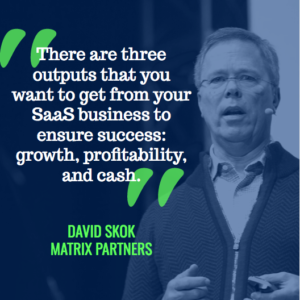
The first one, I believe, is growth. Growth is really fundamental to how we grow the value of our business, but it has a second value, which is if we’re in a competitive marketplace, we need growth to beat our competitor and avoid them from winning our space.
The second two are kind of obvious, profitability and cash. Profitability is how you get greater valuation for the business and cash also, but cash is fundamental to how you survive.
I think it’s useful to just remember at the highest level what we’re doing when we try to run our SaaS business. In my view, it’s trying to optimize around those three variables. I want to try and expose the innards of this machine, this box, and help with using models to show you which of the dials really matter in terms of moving those outputs effectively.
The first question that I think is interesting is to understand why SaaS is so different. I think many of you already know this, but nevertheless let me quickly go over it because it’s material to some of the future points.
This slide shows the cashflow for a single customer. It represents the problem and the conundrum that SaaS creates, which is we start off in month zero having spent a ton of money to acquire this customer. We only get that money back after quite a long period of time, in a small series of cashflows that come in over the lifetime of that customer, then.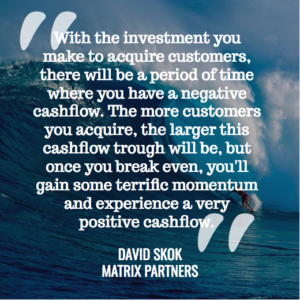
The thing that’s worth looking at here is that the cash impact of that, so if this was your cash balance, you’re going to have this quite significant period of time where you’ve got cashflow negative, because of the investment that you made. It takes, in this particular example in my model here, it shows about 13 months required to break even on that investment that you made in that customer.
That’s fine for one customer, but remember, we’re talking about growth, here. What happens if the cashflow’s bad for one customer, and you now decide to go out and get multiple customers, which is what everybody wants, what happens when that takes place?
Here’s the model effect of that. In the orange, you can see how your cost of customer acquisition is building, because we’re adding more and more customers every month. We’re slightly growing, growing, growing our bookings. The green shows us what’s happened to revenue.
Those are the point in time look at the profit and loss items, here, but to really understand this we have to look at the cumulative cashflow, which is this diagram. The bad news about this diagram is that it shows that we have quite a serious cashflow trough. This is the thing that is so important to understand.
When you’re in your boardrooms trying to explain to your investors why everything’s going really well, we’re growing like crazy, and they’re saying, “But your losses are getting worse, and you’re burning all this cash. How can you tell me things are going well?” You need to have this story up your sleeve, to be able to explain to them what’s going on, there.
The great news about this slide is that once you come out the far end you can see that there’s some terrific momentum, and you do come out into a very positive cashflow situation. It is a good business model, but it requires a lot of cash to get it through that trough, there.
I love this quote from one of the co-board members. I’m on the HubSpot board, and Ron Gill who’s the CFO of Netsuite is our audit chair.
He said, “The thing that surprises many investors and board of directors,” and he’s referring to the Netsuite board of directors, here, “…about the SaaS model, is that even with perfect execution, an acceleration of growth will often be accompanied by a squeeze on profitability and cashflow.”
He is finding himself constantly re-explaining why every time they get close to break even, they decide to go for another bout of investment. Maybe they do some international investment, and the damn thing goes back into a nosedive again. He’s got to try to get them calmed down, and have them understand that it’s going to come right.
The impact here of increasing growth is worth understanding in the model. Not surprisingly, the trough deepens if you increase the number. It’s pretty linear, so if you go from 5 customers per month to 10 customers a month, you double the depth of the trough.
What’s not so obvious is that the actual time for it to come back into profitable mode doesn’t change, and the other thing that’s pretty obvious is that the slope at which it comes bouncing out of that trough is obviously twice as fast. That’s a useful thing to be aware of.
We’ve got an interesting conundrum here, because there are good SaaS businesses and there are bad SaaS businesses. If you’ve got a business that’s growing losses and diving into the floor, how are you able to tell whether you’ve got one that’s actually good and will finally come out of this nosedive?
We need a new kind of metric. GAAP accounting doesn’t deal with this at all, because it doesn’t look at the future revenue values that you have. We’re going to introduce this concept that I think is now very well known, of using unit economics. I think many of you are familiar with customer based unit economics. I’m also going to introduce you to salesperson based unit economics later on in this presentation.
Customer unit economics, let’s start with that, is an incredibly simple concept. The concept simply is, one of the most important aspects of the business model, can I make more profit from this customer over their lifetime than it costs me to acquire them? Pretty straightforward.
That means that we need to look at two variables, CAC and LTV. By now, I’m sure I don’t need to explain these to anybody in this audience here at all. Our goal, again, to state the obvious, is we need the lifetime value to be much bigger than the CAC.
One of the things that always continues to surprise me here, particularly with first time entrepreneurs is, how much they under appreciate the importance of CAC and how big it actually is. I think there’s a ton of optimism, that if they build this great product, everybody’s just going to beat a path to their door.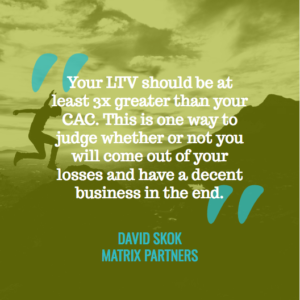
A long time ago, I came up with a guideline that you should have your CAC as being a third, or your LTV should be three times greater than your CAC. I guessed at that number, after visiting many, many SaaS companies. This was probably about, I think, seven years ago or so when I first spread this.
The good news is that I think this has really still held up today as a minimum threshold for a viable business. This is one way to judge, if you’re going into losses that you are going to come out and have a decent business at the end.
Given that we care about these two variables, CAC and LTV, I thought it might be helpful to take a deeper look at the right hand side, the LTV side. The basic formula for how you get to lifetime value of a customer is pretty simple. You look at how much profit per month do they generate, multiply that by the number of months of expected lifetime.
Let’s look at the customer lifetime formula. It’s, again, something I’m sure all of you know. It’s one divided by churn. That tells us something. We really need to care a lot about churn. Everybody in this audience knows that, but let me focus in on it a little bit deeper here and go into some thoughts on how you can deal with churn.
The first thing to note is that there are two kinds of churn. I’m still constantly amazed by how rarely I see both of these being tracked and tracked separately, because they each teach you something different. The best way I can illustrate these two forms of churn is to give you a very simple example.
Imagine we have a cohort that we sign up in January of 2016 that has two customers only. One is spending $5,000, the other one’s spending $1,000 per month with you. Let’s look a year later and see what would happen if we lost the big customer here.
Our customer churn is 50 percent because we lost half of our two customers, but our revenue churn in this particular case is actually 83 percent, because we lost the biggie. This is a serious problem and quite a worry here.
Obviously, nicer would be if we lost the smaller customers, but the real powerful thing is when you look at the other option. Which is, if you could grow the second, remaining customer by more than the amount that you lost from losing that very first customer, something truly magical happens here, which is now we’ve still got that same 50 percent customer churn, but we’ve got -16 percent revenue churn.
This is one of the most important concepts. I’m sure many of you already know this, but I cannot stress highly enough to you just how big of a deal this particular dial is in a SaaS model, because I spend a lot of time modeling things to try to figure out which of these dials matter. This is a big one.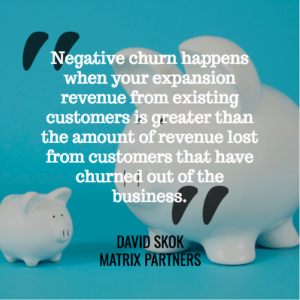
Just to repeat what we’re dealing with here, this is a situation, negative churn happens when your expansion revenue is greater than the amount of revenue that you’d lost from the customers that churned out of the business there.
To get expansion revenue, we need another part of our sales funnel. We’ve got to add on something after we’ve made the sale to get some expansion revenue, through cross sells or upsells or expansion. That’s a problem for many entrepreneurs who are starting their first business, because, “Hey, we’ve only got one product. How the hell do we cross sell? There’s nothing to cross sell here. We’ve got no other things to sell.”
This is one of the big learnings that we had at HubSpot. HubSpot if you remember in the early days had just a single price product. The big deal that we had to understand is that we needed to introduce variable pricing axes to allow us to get more revenue out of an existing customer.
One way to do that is to have multiple versions of your product, like a pro edition and an enterprise edition. Another way is to charge, for example, for users, but quite a lot of businesses don’t happen to increase the number of users like in New Relic for example, or a HubSpot actually.
They have a different way of going, which is to measure the depth of the usage. HubSpot charges for the number of leads. That’s pretty cool since HubSpot actually generates more leads. They’re actually going to automatically, if their product works, increase their LTV over time, which is nice. The Dropbox mechanism is charging for storage. New Relic charges on a per container or server core instance. Those are key things to think about.
Again, I would warn you here that a lot of what I’m talking about, you should ignore if you’re still searching for product/market fit because this is fairly…This is the stuff that you want to be thinking about as you’re coming out of product/market fit and you’re starting to try to think about expansion.
Don’t panic about this too early. I’ve had a lot of entrepreneurs who are just getting their product to market freaking out because they don’t yet have variable axes. Wrong thing to focus on. Just worry about getting product/market fit at that stage then.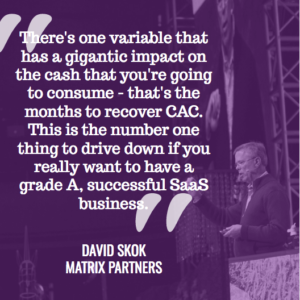
I mentioned that cash is one of those three outputs that we care about. It turns out there’s one variable that has a gigantic impact on your cash that you’re going to consume. That is the months to recover your cost of customer acquisition, months to recover CAC, a simple variable.
One of the ways I can illustrate to you how powerful this is, is to show you this chart where the green line represents six months to recover CAC, the orange line is 12 months to recover CAC, and the deep orange bar on the bottom there is 18 months to recover CAC.
In the top instance, I’m going to have a hard time reading this here, but it’s something like $36 million in cash in the bank at the end of 40 months, whereas the bottom line is $0 at the end of 40 months.
This is a gigantically powerful lever. You probably have all heard of it, but you may not have appreciated how important this variable is. If I want to stress one thing to you today, it’s this one. This is the number one thing to drive down if you really want to have a grade A, successful SaaS business.
This is the difference between Atlassian, who really didn’t have to raise any capital to expand their business and some of the other companies out there that have raised $300 million to get to the same kinds of revenue run rates. It’s focusing on this particular thing here.
My guideline that I like to use is try to get your months to recover CAC to 12 months. I will tell you that very few businesses actually do achieve this. There’s an awful lot more that are at the 18, 20 month range, but they will chew through cash.
There are a lot of businesses that have managed to get it lower, so don’t freak out if you can’t get there, but just be aware you’re going to be raising a lot of venture capital. We’ll probably enjoy being there at the time when that happens. It’s not a disaster, but it’s definitely something valuable to know.
One of the reasons this can be so useful is if you’re looking at a new channel to go and buy leads with, ask yourself a question. “With this lead channel here, if I know how much money I get from a customer in 12 months, that tells me how much money I can afford to spend to get leads through this new channel and still have a really good outcome from it.” That’s another way you can use that formula.
Let’s take a deeper look at the other side of the equation. Let’s have a look at CAC and see what we can do about that. I’ve found that one of the most powerful things to look at with CAC is sales complexity. It stands to reason that if you have a really simple product like Dropbox that can be evaluated in about 30 seconds and spreads virally, that’s going to have a very low sales complexity.
If you have an enterprise product where you’ve got to use a sales engineer to go out there and help get it sold, that’s going to be a more complex sale. It’s probably going to cost more money, particularly if it’s a high price and needs lots of decision makers to agree on it.
I put together a series of businesses. On the left hand side, I’ve got a freemium business, which was Dropbox at the very early days. Not so much now. In the left of that is no-touch self service with Zendesk. In the very early days of Zendesk, they got to about twelve million in ARR with only one sales guy because they had a no-touch self service model then.
Then I have Constant Contact as a data point where they were using a very light touch. Not really selling so much as helping coach the customer through the early usage in a trail.
Then I had HubSpot as a good example of a high-touch inside sales. They were doing a lot of work on their inside sales cores. Then I had a couple of other companies that I worked with. One called Netezza that sold data warehouses that cost a million dollars. They were using field sales people and SEs.
In my mind, I have this picture that this correlation of CAC would be roughly linear to how complex sales was. I went out and got the numbers and something shocking happened. I discovered that it wasn’t at all linear, it’s exponential.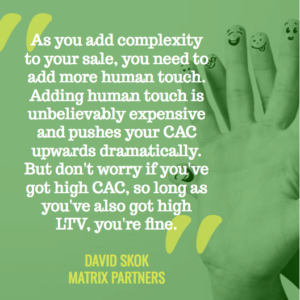
I really was shocked by this and spent a lot of time thinking about it. This graph maybe shows you the key conclusion. This is a logarithmic scale on the left hand side. As you add complexity to your sale, you need to add more human touch into the sale. Adding human touch is unbelievably expensive and pushes your CAC upwards dramatically.
Don’t worry if you’ve got high CAC. So long as you’ve also got high LTV, you’re fine, but if you’re sitting in the audience trying to think about, “How do I improve my SaaS business model,” this is one of the places where you really can do something fascinating.
That is to use your engineering group and your product group to drive CAC down. Most people think of CAC as being in the domain of the sales department, the marketing department. It’s not. It is a whole company effort.
The top thing that I think great SaaS CEOs do is they recognize that every department works together to ensure customer success, to ensure low CAC, and that you can use engineering to drive those things down there.
Let’s switch gears for two seconds. You remember I talked to you about unit economics at the salesperson level. Why does that matter? When you’re creating your business model for 2016, I’m sure all of you sat down and thought, “How am I going to figure out how much revenue we’re going to book?”
I bet you almost everybody here said, “Well, we can probably look at the quota of a salesperson and if we’ve got two salespeople, it will be double that quota. If we’ve got 10 at the end, it’ll be 10 extra quota then.” This is the unit by which we model and create growth in our companies as we hire salespeople.
Let’s have a look at what kind of economics a salesperson has. This shows you what you’d hope would be the revenue growth. It starts slow as they’re ramping, and then you get predictable additions to MRR. The problem is that we have to pay that salesperson from day one at pretty much the full rate.
That means we have a lot of losses in the early days of the salesperson. When you look at those losses cumulatively, you get a shock. The shock tells you that, in this pretty simplistic example, just looking at the salesperson alone, it costs you $110,000 of investment before that person starts to turn around and generate money for you.
Worse still, it takes 23 months to get back the investment on that single salesperson.
That’s a pretty shocking piece of information, right? That’s a long time to get a payback and it’s pretty scary how many of those sales guys don’t actually work out. You discover that you’ve made that investment and you’ve been investing for quite a while there.
The good news is that there is a terrific return of investment once they do start to come out the far end of this thing, but now you get into this point where if you got product market fit, you need to expand. We want growth, right?
We’re going to look at what happens if we hire two of these salespeople every single month. The scary part of that is you’re going to have a gigantic cash flow trough. This is the reason why HubSpot has raised so much money and chewed through so much cash. Even Zendesk, with a very efficient sales model, also raised a lot of capital and burnt through a lot of cash here.
Modeling this is super important because if you don’t have the picture to show your investors and board members of how this finally does turn the corner, they’re going to have a hard time dealing with the investment level that you need.
I do believe, personally, that it’s extremely important if you’re confident about product market fit, and you’re confident that your sales model is repeatable and scalable that you hit the gas. Why? Because most of the time you’re in a competitive marketplace, and you have to win the battle against the competitor.
I know this is somewhat counter to potentially the new talk after the earthquake in the stock markets. If you have cash and you can afford to invest it, this is a great place to invest it there.
One quick thing that’s useful to know is, if you hire one sales person per month instead of two you simply change the depth of the trough, but you don’t change the date in which the thing comes out there, but you do change the slope at the end there.
Let’s jump to another guideline for you, and probably many in the audience will actually have some thoughts on this. My view is that for a sales person we need to look at the cost versus the ROI. The cost is their on target earnings on the left hand side, the OTE. On the right hand side is the benefit they bring us, the quota.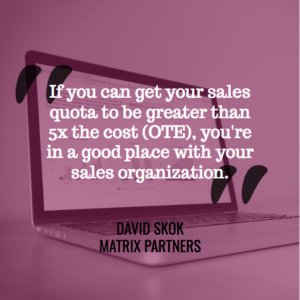
What I’ve found is that looking around at a lot of companies here, if you could get the quota to be greater than five times the cost, you’re in a good place with your sales organization.
There are quite a lot of people that don’t reach that. This is, again, a guideline, it’s for how you get to a great business. I’ve seen businesses that are up at the seven or eight x quota to OTE for the unit economics there.
One last point here before I summarize. Cash, one incredibly powerful thing as a lever for you guys, is if you can, instead of getting monthly payments, get paid annually in advance, look at the right hand graph here, and you’ll see at the end of 40 months here, we have 35 million in the bank versus the other one which is up at about 4 million in the bank.
This is one of the most powerful things you can do, if you can do it without damaging your sales cycle. Not many people can do that, so one of the things that you could do is perhaps reward your sales people for how much cash they bring in upfront, it’s like a secondary aspect of their comp.
Quickly summarizing for you, the key drivers here, I had hoped to try to boil this down to something really simple, I think it’s three things. I’ve written two on this slide, months to recover CAC, hyper important value to tackle.
LTV to CAC ratio and then collecting cash upfront would be the third one on the slides. Quick summary here of how do you reduce CAC? Lower your cost per lead, increase your funnel conversion rates. Increase your productivity per rep. Simplify your product and reduce human touch.
If you want to increase LTV, go like crazy for negative churn, which is all about increasing your product’s stickiness, selling to the right customers who aren’t going to churn, nailing your onboarding and customer success, using variable pricing axes to allow you to actually to have something to upsell, and then having a great expansion sales organization.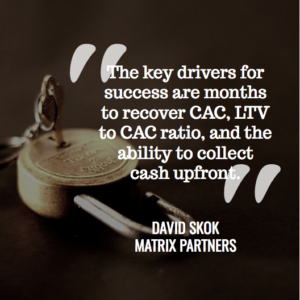
Also worth noting, I didn’t have much time to talk about it, but gross margin as a percentage is actually a key factor here, and then increasing average deal size.
I apologize because I have raced through a subject here that I normally like to take about an hour to go through slowly. The only good news I can say is that a lot of this material is up on the blog. The models are up on the blog, you can play with the models. You can fine tune them, you can copy them, and build your stuff around it.
That hopefully was of some value to you guys. Thank you.
Alex: David, you’re a SaaS rockstar because everyone was holding their phones up while you were presenting. They were trying to take photos of the slides you’re putting up. Of course, it is on your blog.
One thing that I was curious about is, let’s say I just saw this presentation, and I’m not happy with my months to recover my CAC.
In your experience, have you found that it’s easier to add more services, or improve your profit margin and increase the money coming in versus maybe not hiring as many sales people, maybe cutting down on the cost on the expense side, and try to bring that time down on the other side?
David: If you’ve got the kind of customer that is like a larger customer, it’s definitely easier to do what you’ve said. Which is raise the prices effectively, sell them something at a higher price point than it is to reduce CAC.
CAC is a really tough nut to lower. It takes a lot of hard work, and it can take ages to get it under control. If you’re a Constant Contact and you’re selling to very small businesses, it’s super hard to get them to pay more than the 36 bucks a month that they were charging.
That’s why Constant Contact really struggled to grow beyond the 400 mill or so. They just didn’t have a way to create expansion revenue beyond that initial sale there for them.
Alex: What about if I see my trough, and I see the convergence towards profitability and I’m not happy with the scale that I’m projected to get to. Is it possible to successfully re-deepen your course?
David: Yes. Yes. Actually one of the slides that I removed was something that Ron Gill gave me, which showed what had happened at NetSuite. Which is they had repeated troughs, they went and ran through an experiment where they first expanded the sales organization.
Then they went and realized, “OK, this is working really well, let’s do more of it.” They added a lot more sales people, and then they went and did international. That was yet another one of these. Provided that you got the cash available to do it, it is the smart thing to do.
Because this machine is like a cash machine, if you put a dollar into it, provided your LTV to CAC ratio is right and your months to recover CAC is right, you will get an amazing stream in return of dollars coming out of that machine later on.
It’s about the best cash bank you can go to that’s going to generate money for you, if it’s a return on your investment.
Alex: When it comes to hiring sales people, there are a lot of factors, obviously the founders are thinking about. What’s the quality of these sales people? What’s the culture? How many people can I inboard at any given time without overwhelming the system?
At the same time, if I can afford it. It looks like if I hire more salespeople, and the return will eventually be there. Being aggressive could really help scale. I’m curious, what’s the number one thing that you would recommend founders to look for as the limit to the pace of growth that they would want with their sales team?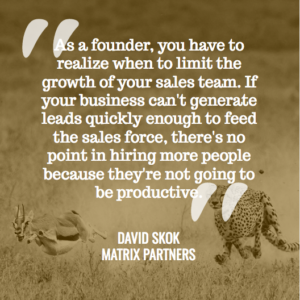
David: I think it’s two things. The number one limit that I see is that they can’t generate leads quickly enough to feed the sales force. It’s no point in hiring more people because they’re just going to sit there and not be able to be productive.
Solving that is a tough challenge and it requires them to go and experiment with multiple marketing lead sources. Clearly the top long term I believe in is inbound. The problem of inbound is that it doesn’t work very well in the early days.
It is a long, slow, linear build. Constantly experimenting with new ones, one of my portfolio companies is Namely. I think many of you guys might have seen that Namely is doing TV ads. They did a lot of advertising on cabs and in bus stops.
Many of the SaaS companies have tried radio. Being able to look for very scalable lead sources has to be cracked before you could really just hit the gas on hiring the sales people. That’s one of the piece of this presentation that I felt I had to cut out to try to fit in the timeframe here. Thank you for asking the question.
Alex: You crammed a ton in there. One point that I was also very curious about is, you were presenting the idea of upselling current customers and improving your return from you existing customer base. We hear a lot in enterprise now about customer success as a term.
I’m curious with your portfolio with the companies who ask you for advice, what’s the first thing they should do, to try to get current customers on that path to maybe a $1.50 for every dollar the year before. That would be ambitious but that would be great.
David: We did hear some great numbers. Zendesk is at about 123 percent dollar retention rate. New Relic mentioned 129 percent yesterday. There are some great numbers out there to encourage you that this is possible.
I’d say that to me the top two things that I’ve seen affecting churn, the first one happens in the first 90 days of the customer’s lifecycle and it’s the onboarding. The customer is super excited about your product after they’ve just purchased it.
If they have a bad experience with the onboarding, it’s really hard to get them to pay any attention to you again. Pouring energy and effort into that first few weeks of experience with an onboarding process that really does a great job in getting them on.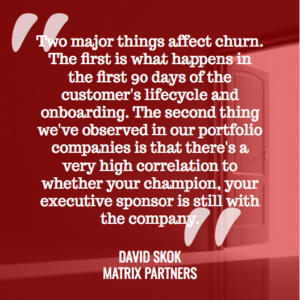
The second thing we’ve observed in our portfolio companies is that there’s a very high correlation to whether your champion, your executive sponsor is still with the company. A trick that might be worth watching here is the health of the customer.
The happiness score should include looking to see whether you have executive sponsorship. If somebody leaves, to make sure that you’re get executive sponsorship with some other person there. Not just getting the thing just settled in off the ground there.
Alex: How would you rate the employee cost of having the right people to maintain relationships relative to going for new leads with new sales people?
David: It’s a great question and I skipped over gross margin. If you know the gross margin calculation, the piece that most people think of is that this is our hosting costs with Amazon. It’s not just that.
The second piece that goes into that is exactly the customer success team that is required to actually make the product and the support team. Those costs go in there and they drag down your LTV because it will impact that particular part of the formula if they are very high.
Again, it goes back to that concept of how do you make your product simpler. Not just thinking of this is being the job of the customer success team. It’s the product managers and it’s the engineers who can have the greatest impact on that by changing the product and making it so much easier and more natural and obvious to adopt and learn. Many other techniques as well, but that’s a key one.
Alex: We can talk about this all day, but we’re out of time. I would recommend everyone read some of the amazing work David’s done. Thank you so much.
David: Thank you very much.
Alex: Thank you guys.
You can view the slides from David’s presentation here.
